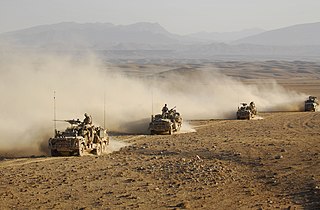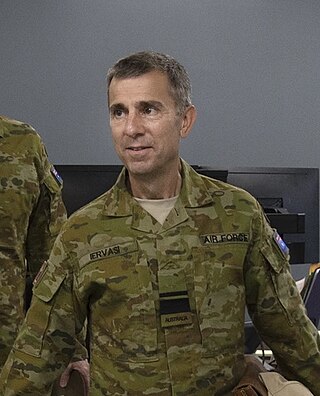Land FEGs
| | This section is empty. You can help by adding to it. (February 2012) |
Force Element Groups (FEGs) are the operational capabilities of the Australian Defence Force (ADF) as organised into component groups.
Capabilities are formed into Force Elements (FE), which in turn are aggregated into Force Element Groups (FEG). Each capability is assigned a level of operational readiness. The level of capability maintained by an FE or FEG should be consistent with its assigned readiness notice and depends on the availability of trained personnel, the availability of major platforms, combat systems and supplies, and the standard of collective training. [1]
Each of the component commands has a set of FEGs. The FEG operational commanders report to the component commanders (COMAUSFLT/CFC/ACAUST), who in turn report to the operation's Task Force commander. The FEG commanders are either of Captain (naval)/Colonel/Group Captain rank, or one-star rank for larger FEGs (Commodore/Brigadier/Air Commodore). The component commanders are of two-star rank (Rear Admiral/Major General/Air Vice Marshal).
There are two parts to the Royal Australian Navy (RAN)'s structure. One is an operational command, Fleet Command, and the other is a support command, Navy Systems Command. The Navy's assets are administered by seven Force Element Groups (FEGs), which report to the Commander Australian Fleet (COMAUSFLT). [2]
The seven Maritime FEGs are:
| | This section is empty. You can help by adding to it. (February 2012) |
Air Command is the operational arm of the Royal Australian Air Force (RAAF). Its role is to manage and command the RAAF's Force Element Groups (FEGs), which contain the operational capability of the Air Force.
Air Command consists of the following FEGs: [3]

The Royal Australian Navy (RAN) is the naval force of the Australian Defence Force (ADF). The professional head of the RAN is Chief of Navy (CN) Vice Admiral Mark Hammond AM, RAN. CN is also jointly responsible to the Minister of Defence (MINDEF) and the Chief of Defence Force (CDF). The Department of Defence as part of the Australian Public Service administers the ADF.

The Royal Australian Air Force (RAAF) is the principal aerial warfare force of Australia, a part of the Australian Defence Force (ADF) along with the Royal Australian Navy and the Australian Army. Constitutionally the Governor-General of Australia is the de jure Commander-in-Chief of the Australian Defence Force. The Royal Australian Air Force is commanded by the Chief of Air Force (CAF), who is subordinate to the Chief of the Defence Force (CDF). The CAF is also directly responsible to the Minister for Defence, with the Department of Defence administering the ADF and the Air Force.

The Australian Defence Force (ADF) is the military organisation responsible for the defence of the Commonwealth of Australia and its national interests. It has three branches: the Royal Australian Navy (RAN), Australian Army and the Royal Australian Air Force (RAAF). The ADF has a strength of just over 89,000 personnel and is supported by the Department of Defence and several other civilian agencies.
A group is a military unit or a military formation that is most often associated with military aviation.

The Commander United Kingdom Strike Force is a senior post in the Royal Navy.
The Royal Australian Air Force is organised into a number of operational, support and training formations located at bases across Australia.
Air Command is the operational arm of the Royal Australian Air Force (RAAF). It is headed by the Air Commander Australia, whose role is to manage and command the RAAF's Force Element Groups (FEGs), which contain the operational capability of the Air Force. Headquarters Air Command is located at RAAF Base Glenbrook.

The Royal Australian Air Force's Air Combat Group (ACG) is the group which administers the RAAF's fighter and bomber aircraft. ACG was formed on 7 February 2002 by merging the RAAF's Tactical Fighter Group and Strike Reconnaissance Group in an attempt to improve the speed with which the RAAF can deploy its combat aircraft.

The special forces of the Australian Defence Force are units of Special Operations Command and associated units of the Royal Australian Navy and the Royal Australian Air Force that conduct and or support special operations to advance and protect the national security of the Commonwealth of Australia. The special forces of Australia have a lineage to a variety of units raised in the Second World War such as the Independent and Commando Companies, Z Special Unit, Navy Beach Commandos, and the Coastwatchers. Australian special forces have most recently been deployed to Iraq in Operation Okra as the Special Operations Task Group, as the Special Operations Task Group in Afghanistan, in Afghanistan in support of the Australian Secret Intelligence Service and regularly for counter-terrorism pre-deploy to locations of major domestic events throughout Australia in readiness to support law enforcement such as the 2014 G20 Brisbane summit.

The Navy Expeditionary Combat Command (NECC) is an echelon III command of the United States Navy, which serves as the single functional command to centrally manage current and future readiness, resources, manning, training and equipping of the United States Navy's 21,000 expeditionary forces who are currently serving in every theater of operation. The NECC was established in January 2006. NECC is a subordinate command of the Navy's Fleet Forces Command.
Air Vice Marshal Alfred John Quaife, AM is a retired senior officer of the Royal Australian Air Force (RAAF).
The Australian Defence Organisation (ADO) is composed of the armed forces of the Commonwealth of Australia, the Australian Defence Force (ADF), and the Australian Public Service government department, the Department of Defence which is composed of a range of civilian support organisations.

The Australian Defence Force Investigative Service (ADFIS) is the unified investigative arm of the Australian Defence Force's Joint Military Police Unit. Initially formed in 2007 as a part of the service police until its amalgamation into the Joint Military Police Force at the beginning of 2020. ADFIS was responsible for complex and major disciplinary and criminal investigations involving the Australian Defence Force (ADF), its assets, land, personnel and capability.
The Australian Defence Organisation (ADO) is composed of the armed forces of the Commonwealth of Australia, the Australian Defence Force (ADF), and the Australian Public Service government department, the Department of Defence which is composed of a range of civilian support organisations.

The Fleet Electronic Warfare Center (FEWC) is a subordinate organization of the Naval Network Warfare Command (NNWC), which was established in 2008 to be the center for US Navy fleet electronic warfare (EW) operational and tactical issues. It is currently located at Navy Information Dominance Forces (NIDF) Headquarters, in Suffolk, VA as an independent directorate.
Fleet Command is responsible for the command, operations, readiness, training and force generation of all ships, submarines, aircraft squadrons, diving teams, and shore establishments of the Royal Australian Navy. Fleet Command is headquartered at HMAS Kuttabul in Sydney, and is led by the Commander Australian Fleet (COMAUSFLT), also referred to as Fleet Commander Australia (FCAUST), which is a rear admiral (two-star) appointment.

The Navy Command is the current headquarters body of the Royal Navy, and as of 2012 its major organisational grouping. It is a hybrid, neither a command, nor simply an installation. Royal Navy official writings describe Navy Command Headquarters both as a physical site, on Whale Island, Hampshire, a collective formed of the most senior RN officers, and as a budgetary grouping.
The Information Warfare Directorate of the Royal Australian Air Force's Air Warfare Centre (AWC) is the Australian Defence Force's central institution dealing with tactical information warfare.
Air Marshal Warren George McDonald, is a retired senior officer of the Royal Australian Air Force (RAAF). He joined the RAAF as a 15-year-old apprentice and, in 1989, underwent pilot training. A series of squadron and staff postings in Australia, Canada and Malaysia followed, before he was appointed to command No. 11 Squadron (2007–09), No. 92 Wing (2009–11) and Air Mobility Group (2013–15). He was Deputy Chief of Air Force from July 2015 to May 2017 and the inaugural Chief of Joint Capabilities from July 2017 to November 2020.

Air Vice-Marshal Vincent Joseph Iervasi, is a retired senior officer of the Royal Australian Air Force (RAAF). He joined the RAAF in 1985 and gained his pilot's wings in 1989. He deployed to Bosnia and Herzegovina on Operation Deny Flight in 1995, Qatar in support of Operation Slipper in 2014, and to Al Minhad Air Base in support of Operations Okra and Highroad in 2019. He commanded No. 3 Squadron RAAF (2005–08), No. 81 Wing RAAF (2011–12), the 609th Combined Air Operations Centre (2014) and the Air Warfare Centre (2017–18). He was Commander Joint Task Force 633 from January to June 2019 and served as Air Commander Australia from 2019 to 2022.